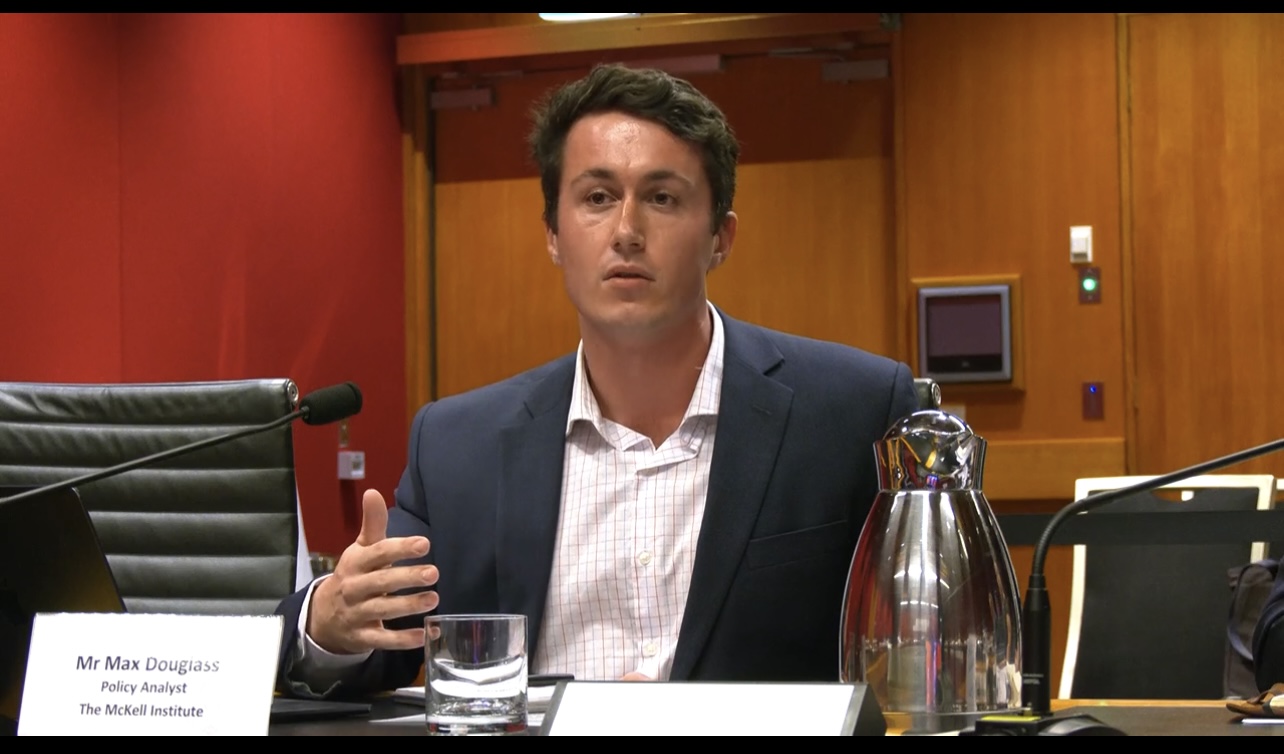Alongside Business NSW and Unions NSW, McKell Institute Policy Analyst Max Douglass appeared before the NSW Parliament’s Select Committee on Essential Worker Housing to make the case for unleashing institutional investment in essential worker housing. His full remarks are as follows:
I’d like to begin by thanking the Committee for extending an invitation to the McKell Institute to give evidence today.
We’re an unashamedly progressive thinktank that works with a broad cross section of organisations across Australia—from business to government to the union movement—to drive debate, build consensus and, ultimately, provide pragmatic evidence-based solutions to the most pressing policy issues of the day.
The opportunity to appear before the Committee today on the critically important issue of essential worker housing is of particular significance to the McKell Institute for a couple of reasons.
First, housing policy—and especially housing policy for working Australians—has always been part of our institutional DNA and policy expertise. Since the McKell Institute was launched in Sydney in 2012 with our Homes for All report, we’ve driven debate on rental reform, developed novel proposals on housing taxation, and made the case for generational investments in social housing. We see it both as both a great privilege and great responsibility to be able to make a further contribution here today.
And secondly, our submission, and the opportunity to present here today, represent a shining example of one of our key missions: building consensus among diverse stakeholders. Our recommendations—especially regarding how we attract and retain institutional investment—have been discussed, debated and ultimately endorsed by both Business NSW and Unions NSW.
In other words, we’ve worked hard to get both sides of the aisle on board.
25 years ago, teachers, nurses, firefighters and aged care workers could afford to purchase a home and plan a stable future in NSW.
Today they cannot even afford to rent one.
The fact that there is a need for this Committee’s inquiry at all should tell us that something has gone drastically wrong in how we do housing policy in NSW and Australia more broadly.
In 2025, essential workers are travelling hours to work, skipping meals, and falling behind on bills—all just to survive. Indeed, by some estimates, some 78 per cent of them are in housing stress.
For many, the prospect of home ownership has been evaporated by runaway house prices, and eye-wateringly high rents which eat away any ability to save for a deposit.
And for younger essential workers, this means the stability required for starting a family has become but a pipe dream. It means housing costs have turned children into a luxury reserved for an increasingly small few.
In no uncertain terms, this is one of the gravest policy failures in a generation. But it is also a moral one. It is a most fundamental breach of the social contract.
It undermines the stability, security and dignity of NSW’s most integral workers, but it also threatens the reliability, productivity and safety of essential services in NSW’s cities and regions.
Historically, many essential workers were eligible for once-abundant social housing. And until relatively recently most could afford to rent and eventually purchase their own home on the market.
Today neither option remains open to essential workers. They earn too much to be eligible for social housing, and too little to sustainably rent or purchase housing on the market.
They are caught in the ‘missing middle’.
We see this Committee’s chief function as to provide solutions plug this missing middle. Our submission proposes seven recommendations—most of which are concerned with attracting and retaining institutional investment in essential worker housing, particularly build-to-rent.
In 2021 it was estimated $290 billion would be needed over the next 20 years to meet Australia’s shortfall in social and affordable housing. By all accounts, this requires active collaboration with and participation from private capital, especially Australia’s $4 trillion superannuation savings pool.
It is equally crucial to recognise that private capital cannot do the heavy lifting alone.
The NSW Government must use all the tools at its disposal to close the so-called funding gap—that is, the fact that returns generated by essential worker housing investments are typically insufficient to meet an appropriate return—and sometimes even the cost of provision—without some form of subsidy or concession.
Altruism can only get us so far. If we want the private capital we need, it is the NSW Government’s job to use its balance sheet and the policy levers at its disposal to put the risk-adjusted return of essential worker housing on par with other asset classes.
With the support of Unions NSW and Business NSW, we propose several complementary ways in which the NSW Government might get this done.
Finally, we would caution the Committee about any policy that seeks to entice institutional investment into essential worker housing primarily by the prospect of capital growth in residential property.
Investor returns through runaway price growth would serve only to disadvantage the essential workers of future generations. We should not forget that this Committee’s task is concerned about sustainably housing the essential workers of today, as well as essential workers of tomorrow.
Rather, it is our submission that policies which are based on investor returns through long-term, secure, and scalable tenancies remain the most sustainable and equitable way of attracting institutional investment over the long term.
Thank you.


SOCIAL SHARE